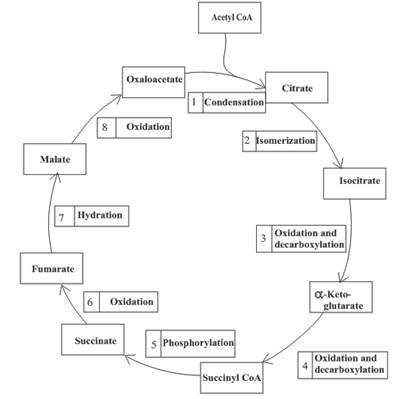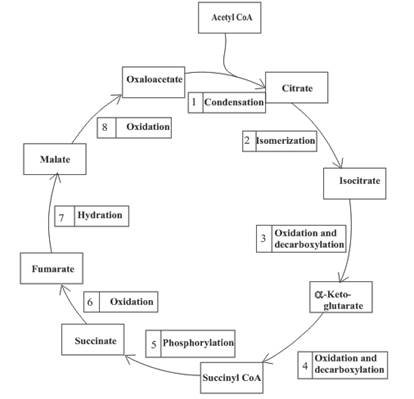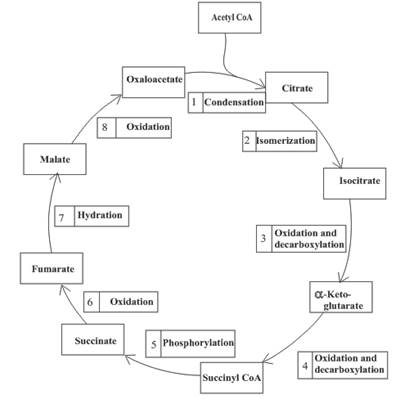
Concept explainers
(a)
Interpretation: To determine the number of CO2 molecules formed during one turn of the citric acid cycle.
Concept introduction: Citric acid cycle is the third stage of the biochemical energy production process. The cycle includes the reactions in which the acetyl part of acetyl CoA is oxidized and leads to the formation of carbon dioxide and

(b)
Interpretation: To determine the number of FADH2 molecules formed during one turn of the citric acid cycle.
Concept introduction: Citric acid cycle is the third stage of the biochemical energy production process. The cycle includes the reactions in which the acetyl part of acetyl CoA is oxidized and leads to the formation of carbon dioxide and

Flavin adenine dinucleotide exists in two forms: oxidized form
(c)
Interpretation: To determine the number of times secondary alcohol is oxidized during one turn of the citric acid cycle.
Concept introduction: Citric acid cycle is the third stage of the biochemical energy production process. The cycle includes the reactions in which the acetyl part of acetyl CoA is oxidized and leads to the formation of carbon dioxide and
An overview of the citric acid cycle is as follows:

(d)
Interpretation: To determine the number of times water adds to carbon-carbon double bond during one turn of the citric acid cycle.
Concept introduction: Citric acid cycle is the third stage of the biochemical energy production process. The cycle includes the reactions in which the acetyl part of acetyl CoA is oxidized and leads to the formation of carbon dioxide and
An overview of the citric acid cycle is as follows:

Want to see the full answer?
Check out a sample textbook solution
Chapter 23 Solutions
General, Organic, and Biological Chemistry
- How does the caloric value of fat compare with the caloric value of glycogen and starch?arrow_forwardList, by name, the four general stages of the process by which biochemical energy is obtained from food.arrow_forwardExplain why monitoring blood lactate levels might be a useful technique to gauge the amount of conditioning in an Olympic runner.arrow_forward
- Order the steps of the endogenous pathway starting with VLDL in the liver. Question 99 options: excess LDL taken up by receptors in the liver LDL circulates to deliver cholesterol to peripheral cells After a meal, VLDL in liver packaged with trigs and cholesterol and sent into circulation IDL transported to liver and broken down into LDL VLDL interacts with LPL to release its fatty acids. Becomes IDLarrow_forward***In determining glucose concentration using a glucometer, the test involves an enzymatic reaction. What is the enzyme which catalyzes the conversion of glucose to gluconolactone? a. Glucose oxidase b. Glucose reductase c. Glucose synthetase d. Glucose peroxidasearrow_forward5. The central substance of carbohydrate metabolism is a. glucose b. galactose c. fructose d. more than one choice is correctarrow_forward
- Glucose is the preferred energy source of the brain, Why?arrow_forward1. What is glycolysis? 2. Discuss the steps involved in glycolysis. 3. What are the enzymes used in each step? 4. Identify the chemical reactions in each step. 5. In which steps are coenzymes used? 6. In which steps are ATP used to activate the process? 7. In which steps are ATP produced? 8. How many ATPs are produced in the glycolysis of glucose molecule? Show the computations. 9. Show how the ATP is computed in the glycolysis process.arrow_forward6. An element used in the body in the form of ions or compounds. a. anabolism b. catabolism Oc. complete protein Od. complex carbohydrate e. macronutrient f. major mineral g. metabolism h. micronutrient Di. mineral Oj. mitochondria k. nutrition I. trace mineralarrow_forward
- The net result of the oxidation of one mole of an 18-carbon fatty acid will be a. 136 moles of ATP b. 166 moles of ATP c. 126 moles of ATP d. 146 moles of ATP e. 156 moles of ATParrow_forward25. Under anaerobic conditions, yeast produces and alcohol during alcoholic fermentation a. lactate b. CO2 c. glucose d. acetyl CoAarrow_forwardWhy are the carbon atoms of fatty acids more reduced than those in proteins or carbohydrates? Please explain.arrow_forward
 Chemistry for Today: General, Organic, and Bioche...ChemistryISBN:9781305960060Author:Spencer L. Seager, Michael R. Slabaugh, Maren S. HansenPublisher:Cengage Learning
Chemistry for Today: General, Organic, and Bioche...ChemistryISBN:9781305960060Author:Spencer L. Seager, Michael R. Slabaugh, Maren S. HansenPublisher:Cengage Learning Organic And Biological ChemistryChemistryISBN:9781305081079Author:STOKER, H. Stephen (howard Stephen)Publisher:Cengage Learning,
Organic And Biological ChemistryChemistryISBN:9781305081079Author:STOKER, H. Stephen (howard Stephen)Publisher:Cengage Learning, General, Organic, and Biological ChemistryChemistryISBN:9781285853918Author:H. Stephen StokerPublisher:Cengage Learning
General, Organic, and Biological ChemistryChemistryISBN:9781285853918Author:H. Stephen StokerPublisher:Cengage Learning Chemistry In FocusChemistryISBN:9781305084476Author:Tro, Nivaldo J., Neu, Don.Publisher:Cengage Learning
Chemistry In FocusChemistryISBN:9781305084476Author:Tro, Nivaldo J., Neu, Don.Publisher:Cengage Learning



